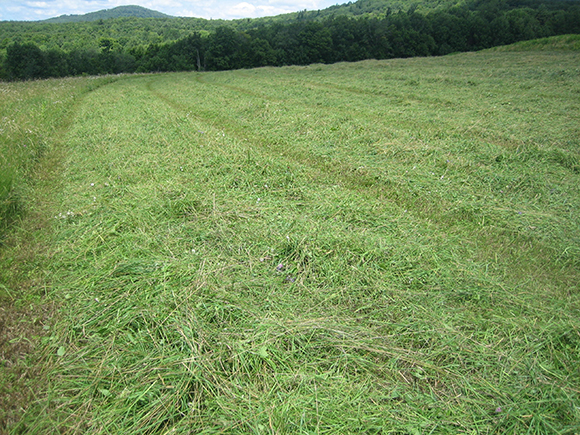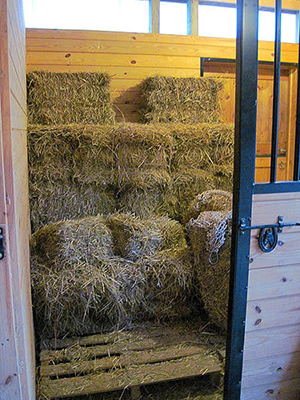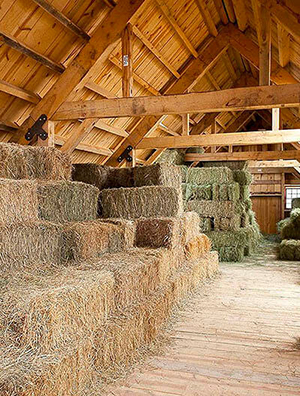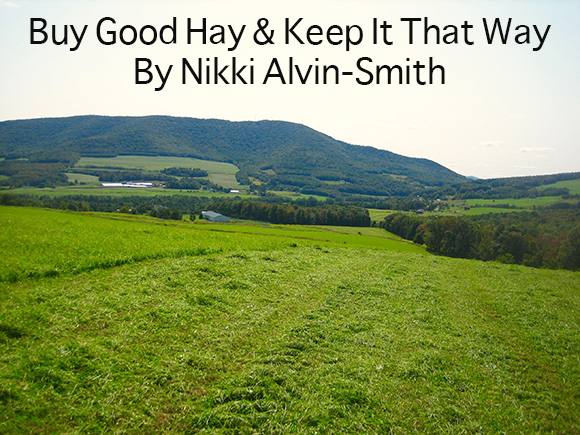Buy Good Hay & Keep It That Way
By Nikki Alvin-Smith
I learned about hay early in life thanks to my wonderful grandfather, ‘Pop.’ As a child growing up in rural Buckinghamshire, England, I was blessed to live on a property with horses, paddocks, fields and super bridleways that weaved through 500 year-old oak trees, with sandy loam soils underfoot and lots of galloping fun.
My grandfather grew up a farmer’s son in the small village of Mentmore. He delighted in sharing his knowledge of everything animal and farming, and one day when I was just 11 years old, he took me into one of our fields to explain to me how to tell when hay was ready to cut. He took the timothy and orchard grass stems, showed me their seedy heads. Pop shook them gently and a few seeds fell, while most remained. He pulled the head of a stem from its base and placed it in his mouth and tasted it. I grabbed one eagerly and did the same. It was a sweet taste. A green grass straw!
“ This hay is ready to cut,” he announced. Pop also explained that it was best to cut around 10 a.m. in the morning, as the sugars rise in the grass after the dew has lifted and thus the hay will produce a higher quality yield.
With the vagaries of English weather timing for hay cutting is difficult, and no-one in our farming neighborhood cut more than once a summer season. Since those early days my passion for horses and fine quality hay has increased tenfold and for the last twenty years my husband and I have produced organically grown top quality horse hay at our farm in the Catskill Mountains of New York. We don’t use any of the 20 plus dry-down agents available, we rely on old-fashioned Mother Nature to cure our hay. All our hay is cured to less than 14% moisture, so it never dusts or presents any issue for combustion and fire. We aim for bales between 11-13% moisture. Hay is cut around 10-11a.m. for the best sugar content.
You may have no experience in choosing good hay, perhaps because no-one ever explained how to select it or perhaps you used to board your horse and someone else took care of the question. You may no idea of how much you’ll need or how to stack it and store it safely.
At Horizon Structures many of our barn purchasers are bringing home their horses for the first time, and frequent questions are:-
How do I store my hay?
How much can I fit into my barn?
How much hay will my horses need to last a winter season?
Hay Selection
When you select hay take a handful from the center of a bale and examine it for dust, moisture and smell. Hay that smells sweet and good enough to eat probably is. Trust your instincts. If the bale is a small square it should weigh on average 40 pounds and be 36 x 16 x 18 inches for a standard small square. Bales that are heavy may contain high moisture or may just be heavily compressed.
Check a few bales from the stack and do not purchase hay from the bottom of a stack if possible. The hay should have been stored with the strings on the side to allow moisture to run through the stack. Guess where that moisture ends up? On the base of the bottom bale of the stack.

Dry Hay All The Way
The farmer has hopefully produced a nice quality bale and the hay has never been wet on the field and then dried out. Bales that have been wet before baling, even if they have been cured to a safe moisture content, will look brown in color. Old hay from the previous year will also be dry and brown. Hay that has been wet and then cured and baled is O.K. to buy it just has a slightly lower vitamin benefit than a bale that was never wet.
Now that the farmer has gone to all the trouble to bale a good bale, and you have spent good money to purchase your supply, you should also go to the trouble to secure a good storage option for your hay supply that is dry and well vented. Hay loves air. Dry air. If your barn roof has a leak, fix it. If your barn loft or storage area is a floor of old hay, clean it out.
 Do not store your hay directly on a dirt, gravel or concrete floor. Moisture will travel up the stack from the bottom and ruin the bottom layer. Place a tarp down and place pallets on top and stack on top of the pallets. This allows an air layer underneath the hay and will prevent mold and dust. Store the hay string sides on the vertical so moisture, that is inherent in all hay, can travel down the stack. If the front of the hay storage is open to the elements be aware that moisture will be drawn to the bottom three or four layers on the front of the stack. It is therefore wise to provide some sort of tarp curtain or door.
Do not store your hay directly on a dirt, gravel or concrete floor. Moisture will travel up the stack from the bottom and ruin the bottom layer. Place a tarp down and place pallets on top and stack on top of the pallets. This allows an air layer underneath the hay and will prevent mold and dust. Store the hay string sides on the vertical so moisture, that is inherent in all hay, can travel down the stack. If the front of the hay storage is open to the elements be aware that moisture will be drawn to the bottom three or four layers on the front of the stack. It is therefore wise to provide some sort of tarp curtain or door.
Another important factor in maintaining air-flow is to stack the bales with at least ½ inch gap between the bales on a layer. Do not be tempted to ‘stuff them in’ for maximum use of space, as this may create a fire hazard especially if the bales are not properly cured.
How Much Hay Do I Need?
There are lots of variables in this question and common sense reigns supreme. A horse in light work, or a horse that is retired won’t need as much hay as a high performance horse. Young and older horses, highly bred horses such as Thoroughbreds may need more hay to maintain their weight than a seven year old Quarter Horse that seems to gain weight on thin air. A general rule of thumb is one bale per day per horse, through winter. The latter horse won’t need second cut as it would be too rich for him, but the high performance horse will appreciate the higher protein level of 2nd cut. So what should you buy and how much? Have the hay tested at your local Extension Office to indicate what its nutritional status will add to your horse’s diet and consult your vet as to quantity based on your individual horse. Factors of general health, age, workload, breed and general nature vary from horse to horse and by treating each horse as an individual you will keep them in optimum health and not waste money. If you have limited grass for example, you will need more hay storage space. If you feed grain you may need less hay. 1st cut is generally cheaper than 2nd and if you can save a dollar or so a bale then go ahead if it makes sense.
Remember quantity discounts will save you money and so aside from the convenience of not making repetitive runs to pick up hay or have it delivered, the more hay storage you have the more you can save cost wise.
Loft or Not?
 There are advantages and disadvantages to hay storage in a loft. The advantages are it is a great use of the space in the top of your building, and with vents added to each gable end and a cupola on the ridgeline of the building, air circulation can be maintained to ensure the hay stays ‘happy.’ It is convenient to add drop down doors above each stall so hay can just be tossed down which saves sweeping up hay from the aisle-way everyday. The disadvantages are the hard work it takes to move the hay to the second level to stack it, (purchasing a conveyor is best or your hay vendor may bring one along and stack it for you), how much weight the floor of the loft can take safely, and that you are creating an environment above the horse’s stalls for dust to accumulate and vermin to live.
There are advantages and disadvantages to hay storage in a loft. The advantages are it is a great use of the space in the top of your building, and with vents added to each gable end and a cupola on the ridgeline of the building, air circulation can be maintained to ensure the hay stays ‘happy.’ It is convenient to add drop down doors above each stall so hay can just be tossed down which saves sweeping up hay from the aisle-way everyday. The disadvantages are the hard work it takes to move the hay to the second level to stack it, (purchasing a conveyor is best or your hay vendor may bring one along and stack it for you), how much weight the floor of the loft can take safely, and that you are creating an environment above the horse’s stalls for dust to accumulate and vermin to live.
Many older barns have loft storage but it may not have been intended for machine made bales. Back in the day the hay was forked loose into the space and had less weight. If you have an old barn be certain to check the viability of the floor and its strength to be certain not to overload the structure.
At Horizon Structures the loft floors will take 60 pounds per square foot. Based on this factor if your bales weigh an average of 40 pounds, 36 x 16 x 18 inches in size (6 cubic feet), and you have a loft space 10 foot high and 12 x 12 foot square, you should comfortably fit 200 bales at 56 lbs per square foot.
If you have a storage space in the building on ground level, such as a 12 x 12 stall with a 10-foot wall, then the number will be the same. If you are possessed you could possibly fit more, even 216 and still maintain a 10% margin of safety, but it is advisable to err on the side of safety.
Naturally if the bales are larger the number will be less. For example, a Horizon Structures customer explained she was able to store 150 bales in the same space. This would indicate that the bales were 9.6 cubic feet per bale.
As you can see, size matters, but this gives you a guideline.
Safety First
If you have any concerns that your hay once stored is building heat then do not attempt to take apart the stack but call the Fire Department. Hay that is baled at too high moisture content, can spontaneously combust. As it starts very slowly to combust there will be a distinct smell. If you reach your hand between the bales and feel significant heat then the process may have started. If you pull bales out of the stack, the influx of oxygenated air may cause it to ignite quickly.
Be aware that if you buy hay directly out of the wagons and it has only been cut a few days, the hay will sweat. This is normal. The hay moisture content will increase a few percent and then return to its original measurement. For this reason, it is prudent to buy hay that is not fresh off the field, especially if you have a confined space in which to store the supply.
How can you test moisture content yourself? You can purchase a hay moisture tester for approximately $120-145 from a tractor dealer or online.
The joy of keeping your horses in your own backyard cannot be overstated. It is a lot of work, but it brings you more time with your horse, more control over his care and tremendous satisfaction. It is always worthwhile to educate yourself as much as possible and ask professionals for their advice. If you have questions check out our catalog at The Perfect Barn or give the friendly Horizon Structures team a call at 1-888-44SHEDS or 610-593-7710. https://www.horizonstructures.com



